Business Administration Report: Analysis of Aldi's Business Functions
VerifiedAdded on 2020/07/22
|19
|4758
|37
Report
AI Summary
This report provides an overview of business administration principles, using Aldi, a multinational company, as a case study. It covers several key units, including delivering presentations, handling mail, storing and retrieving information, maintaining stationery and supplies, and using word processing software. The report analyzes various aspects such as presentation methods, audience engagement, contingency planning, and evaluation techniques. It also explores mail handling procedures, including dealing with junk mail, franking machines, and package preparation. Furthermore, the report discusses information storage systems, legal requirements, and search techniques. It also covers the management of stationery and supplies, including stock checks, ordering processes, and supplier evaluation. Additionally, the report touches on resolving customer complaints, leadership principles, and performance management. The report incorporates relevant organizational policies and procedures, and concludes with a summary of the key findings.
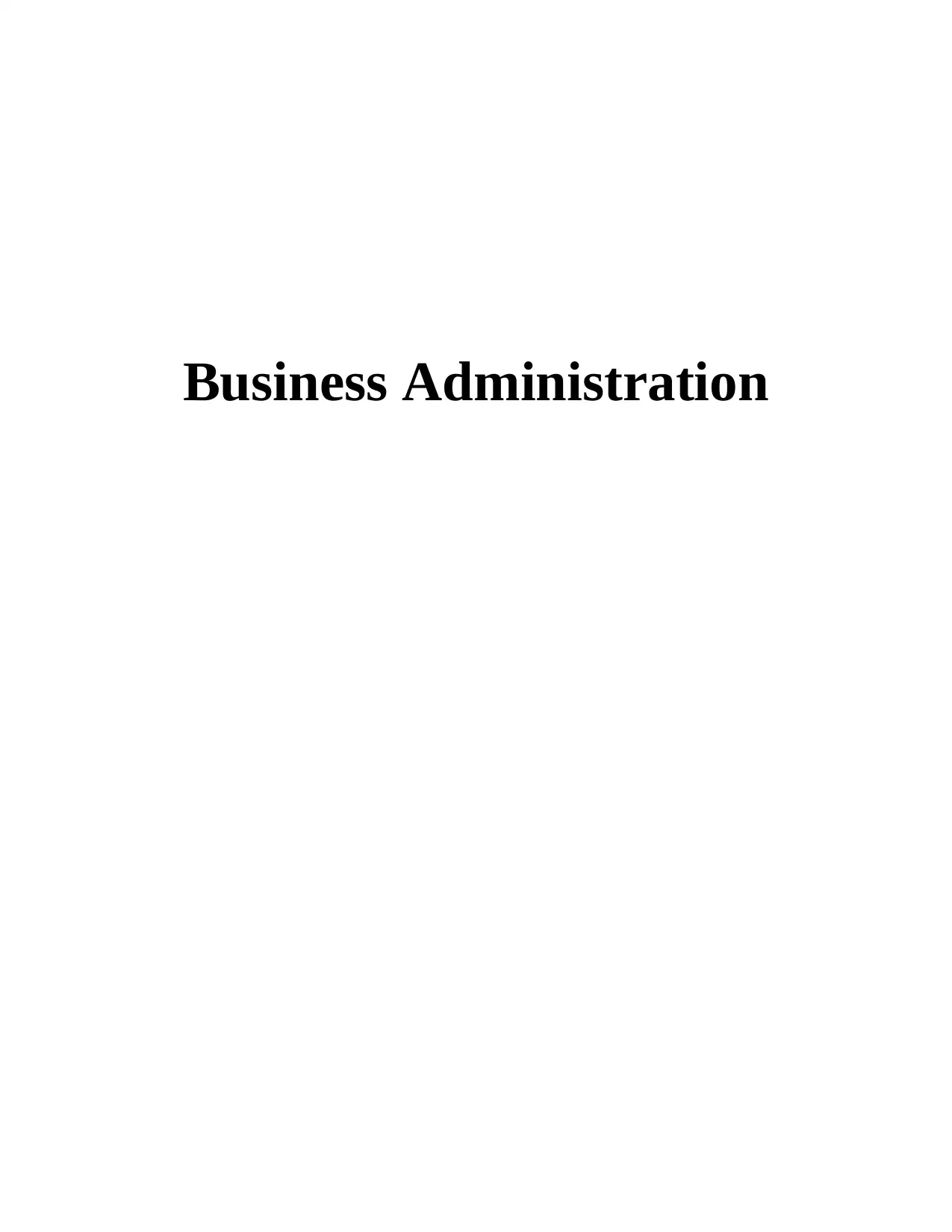
Business Administration
Paraphrase This Document
Need a fresh take? Get an instant paraphrase of this document with our AI Paraphraser
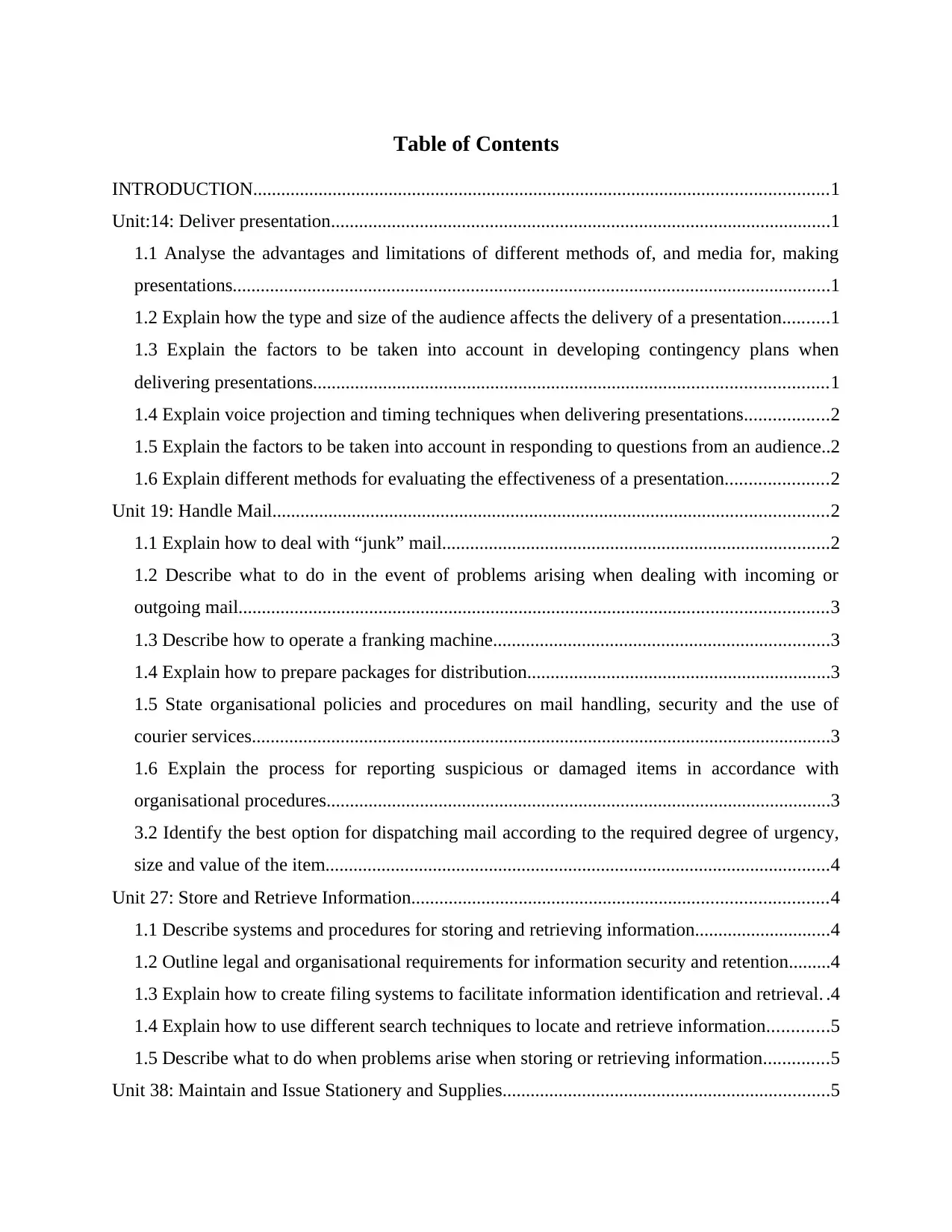
Table of Contents
INTRODUCTION...........................................................................................................................1
Unit:14: Deliver presentation...........................................................................................................1
1.1 Analyse the advantages and limitations of different methods of, and media for, making
presentations................................................................................................................................1
1.2 Explain how the type and size of the audience affects the delivery of a presentation..........1
1.3 Explain the factors to be taken into account in developing contingency plans when
delivering presentations..............................................................................................................1
1.4 Explain voice projection and timing techniques when delivering presentations..................2
1.5 Explain the factors to be taken into account in responding to questions from an audience..2
1.6 Explain different methods for evaluating the effectiveness of a presentation......................2
Unit 19: Handle Mail.......................................................................................................................2
1.1 Explain how to deal with “junk” mail...................................................................................2
1.2 Describe what to do in the event of problems arising when dealing with incoming or
outgoing mail..............................................................................................................................3
1.3 Describe how to operate a franking machine........................................................................3
1.4 Explain how to prepare packages for distribution.................................................................3
1.5 State organisational policies and procedures on mail handling, security and the use of
courier services............................................................................................................................3
1.6 Explain the process for reporting suspicious or damaged items in accordance with
organisational procedures............................................................................................................3
3.2 Identify the best option for dispatching mail according to the required degree of urgency,
size and value of the item............................................................................................................4
Unit 27: Store and Retrieve Information.........................................................................................4
1.1 Describe systems and procedures for storing and retrieving information.............................4
1.2 Outline legal and organisational requirements for information security and retention.........4
1.3 Explain how to create filing systems to facilitate information identification and retrieval. .4
1.4 Explain how to use different search techniques to locate and retrieve information.............5
1.5 Describe what to do when problems arise when storing or retrieving information..............5
Unit 38: Maintain and Issue Stationery and Supplies......................................................................5
INTRODUCTION...........................................................................................................................1
Unit:14: Deliver presentation...........................................................................................................1
1.1 Analyse the advantages and limitations of different methods of, and media for, making
presentations................................................................................................................................1
1.2 Explain how the type and size of the audience affects the delivery of a presentation..........1
1.3 Explain the factors to be taken into account in developing contingency plans when
delivering presentations..............................................................................................................1
1.4 Explain voice projection and timing techniques when delivering presentations..................2
1.5 Explain the factors to be taken into account in responding to questions from an audience..2
1.6 Explain different methods for evaluating the effectiveness of a presentation......................2
Unit 19: Handle Mail.......................................................................................................................2
1.1 Explain how to deal with “junk” mail...................................................................................2
1.2 Describe what to do in the event of problems arising when dealing with incoming or
outgoing mail..............................................................................................................................3
1.3 Describe how to operate a franking machine........................................................................3
1.4 Explain how to prepare packages for distribution.................................................................3
1.5 State organisational policies and procedures on mail handling, security and the use of
courier services............................................................................................................................3
1.6 Explain the process for reporting suspicious or damaged items in accordance with
organisational procedures............................................................................................................3
3.2 Identify the best option for dispatching mail according to the required degree of urgency,
size and value of the item............................................................................................................4
Unit 27: Store and Retrieve Information.........................................................................................4
1.1 Describe systems and procedures for storing and retrieving information.............................4
1.2 Outline legal and organisational requirements for information security and retention.........4
1.3 Explain how to create filing systems to facilitate information identification and retrieval. .4
1.4 Explain how to use different search techniques to locate and retrieve information.............5
1.5 Describe what to do when problems arise when storing or retrieving information..............5
Unit 38: Maintain and Issue Stationery and Supplies......................................................................5
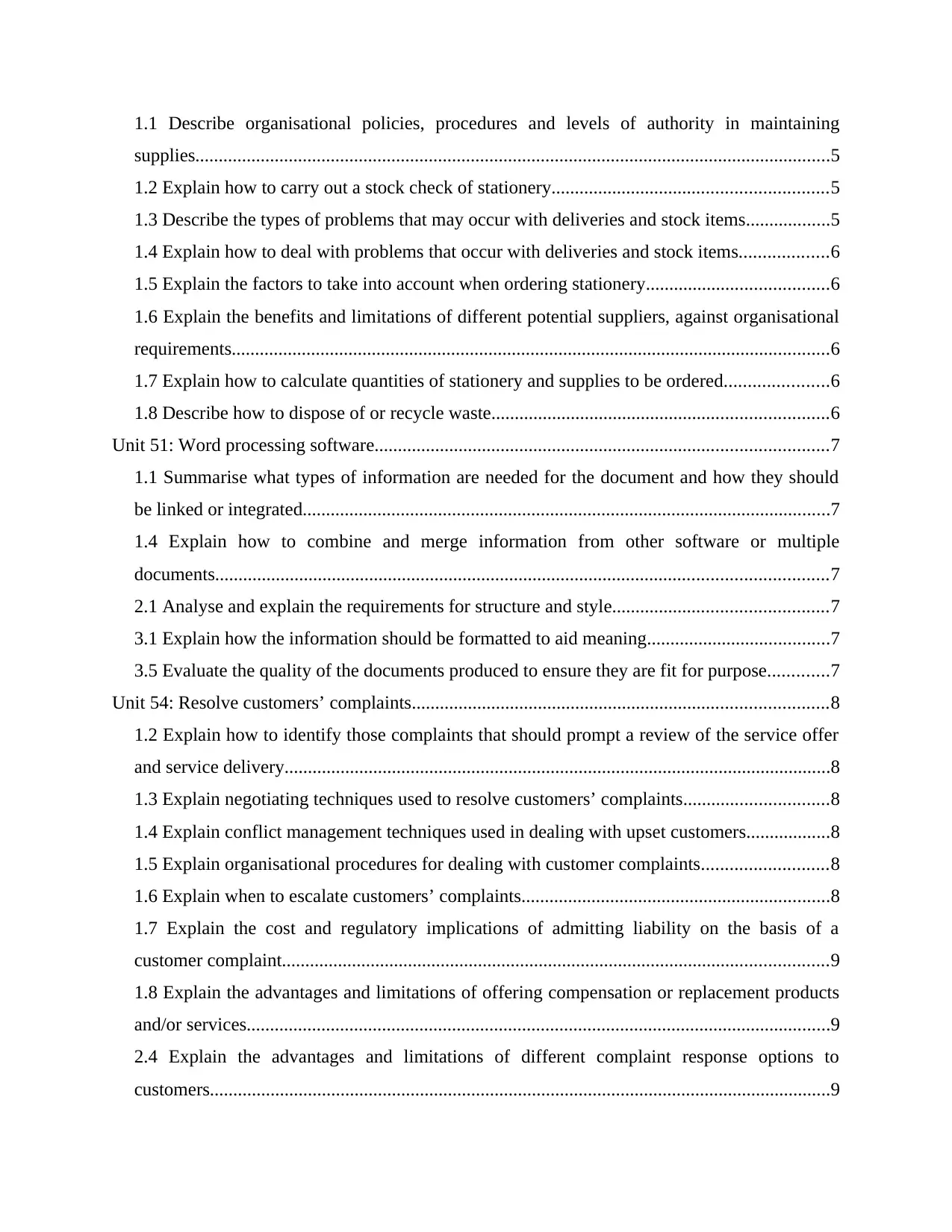
1.1 Describe organisational policies, procedures and levels of authority in maintaining
supplies........................................................................................................................................5
1.2 Explain how to carry out a stock check of stationery...........................................................5
1.3 Describe the types of problems that may occur with deliveries and stock items..................5
1.4 Explain how to deal with problems that occur with deliveries and stock items...................6
1.5 Explain the factors to take into account when ordering stationery.......................................6
1.6 Explain the benefits and limitations of different potential suppliers, against organisational
requirements................................................................................................................................6
1.7 Explain how to calculate quantities of stationery and supplies to be ordered......................6
1.8 Describe how to dispose of or recycle waste........................................................................6
Unit 51: Word processing software.................................................................................................7
1.1 Summarise what types of information are needed for the document and how they should
be linked or integrated.................................................................................................................7
1.4 Explain how to combine and merge information from other software or multiple
documents...................................................................................................................................7
2.1 Analyse and explain the requirements for structure and style..............................................7
3.1 Explain how the information should be formatted to aid meaning.......................................7
3.5 Evaluate the quality of the documents produced to ensure they are fit for purpose.............7
Unit 54: Resolve customers’ complaints.........................................................................................8
1.2 Explain how to identify those complaints that should prompt a review of the service offer
and service delivery.....................................................................................................................8
1.3 Explain negotiating techniques used to resolve customers’ complaints...............................8
1.4 Explain conflict management techniques used in dealing with upset customers..................8
1.5 Explain organisational procedures for dealing with customer complaints...........................8
1.6 Explain when to escalate customers’ complaints..................................................................8
1.7 Explain the cost and regulatory implications of admitting liability on the basis of a
customer complaint.....................................................................................................................9
1.8 Explain the advantages and limitations of offering compensation or replacement products
and/or services.............................................................................................................................9
2.4 Explain the advantages and limitations of different complaint response options to
customers.....................................................................................................................................9
supplies........................................................................................................................................5
1.2 Explain how to carry out a stock check of stationery...........................................................5
1.3 Describe the types of problems that may occur with deliveries and stock items..................5
1.4 Explain how to deal with problems that occur with deliveries and stock items...................6
1.5 Explain the factors to take into account when ordering stationery.......................................6
1.6 Explain the benefits and limitations of different potential suppliers, against organisational
requirements................................................................................................................................6
1.7 Explain how to calculate quantities of stationery and supplies to be ordered......................6
1.8 Describe how to dispose of or recycle waste........................................................................6
Unit 51: Word processing software.................................................................................................7
1.1 Summarise what types of information are needed for the document and how they should
be linked or integrated.................................................................................................................7
1.4 Explain how to combine and merge information from other software or multiple
documents...................................................................................................................................7
2.1 Analyse and explain the requirements for structure and style..............................................7
3.1 Explain how the information should be formatted to aid meaning.......................................7
3.5 Evaluate the quality of the documents produced to ensure they are fit for purpose.............7
Unit 54: Resolve customers’ complaints.........................................................................................8
1.2 Explain how to identify those complaints that should prompt a review of the service offer
and service delivery.....................................................................................................................8
1.3 Explain negotiating techniques used to resolve customers’ complaints...............................8
1.4 Explain conflict management techniques used in dealing with upset customers..................8
1.5 Explain organisational procedures for dealing with customer complaints...........................8
1.6 Explain when to escalate customers’ complaints..................................................................8
1.7 Explain the cost and regulatory implications of admitting liability on the basis of a
customer complaint.....................................................................................................................9
1.8 Explain the advantages and limitations of offering compensation or replacement products
and/or services.............................................................................................................................9
2.4 Explain the advantages and limitations of different complaint response options to
customers.....................................................................................................................................9
⊘ This is a preview!⊘
Do you want full access?
Subscribe today to unlock all pages.

Trusted by 1+ million students worldwide
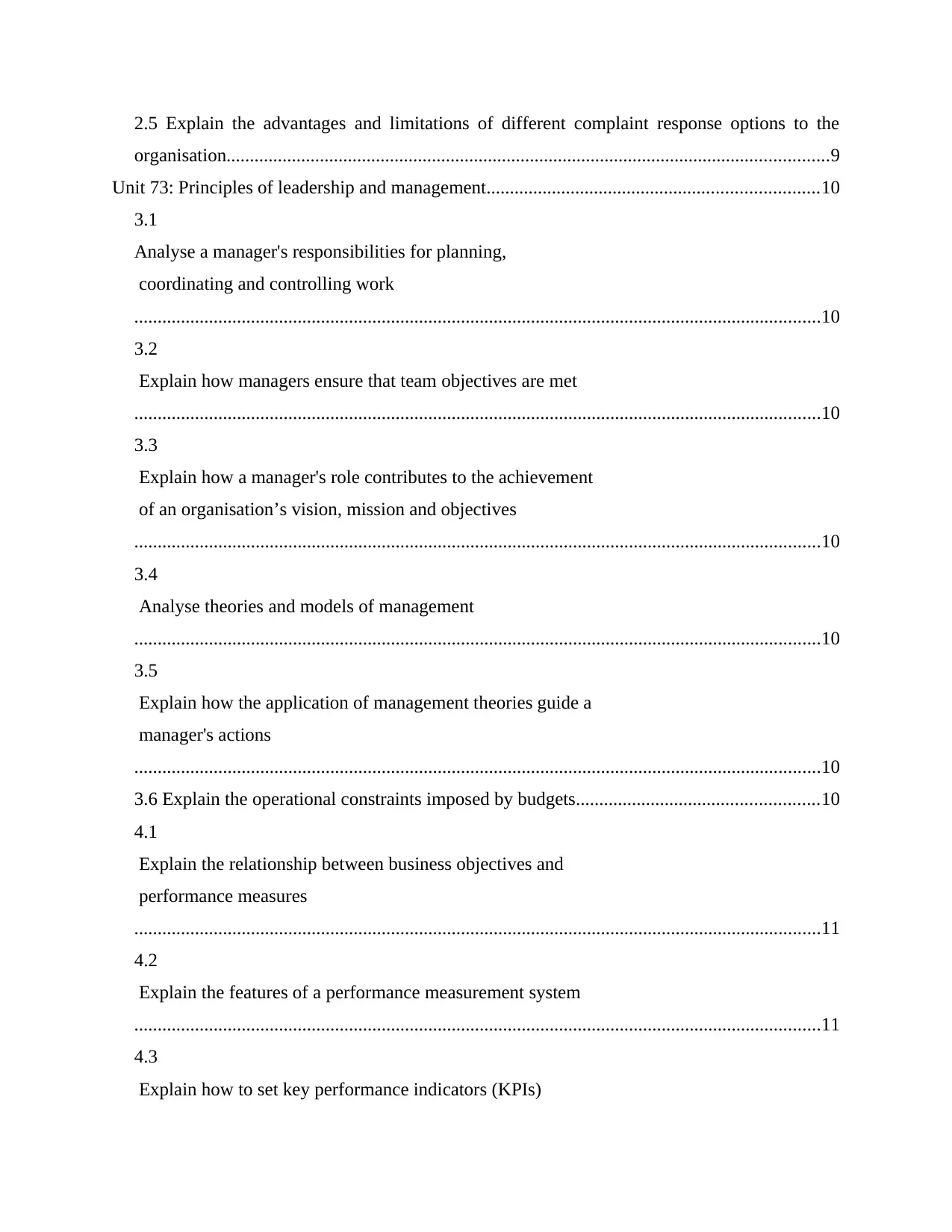
2.5 Explain the advantages and limitations of different complaint response options to the
organisation.................................................................................................................................9
Unit 73: Principles of leadership and management.......................................................................10
3.1
Analyse a manager's responsibilities for planning,
coordinating and controlling work
...................................................................................................................................................10
3.2
Explain how managers ensure that team objectives are met
...................................................................................................................................................10
3.3
Explain how a manager's role contributes to the achievement
of an organisation’s vision, mission and objectives
...................................................................................................................................................10
3.4
Analyse theories and models of management
...................................................................................................................................................10
3.5
Explain how the application of management theories guide a
manager's actions
...................................................................................................................................................10
3.6 Explain the operational constraints imposed by budgets....................................................10
4.1
Explain the relationship between business objectives and
performance measures
...................................................................................................................................................11
4.2
Explain the features of a performance measurement system
...................................................................................................................................................11
4.3
Explain how to set key performance indicators (KPIs)
organisation.................................................................................................................................9
Unit 73: Principles of leadership and management.......................................................................10
3.1
Analyse a manager's responsibilities for planning,
coordinating and controlling work
...................................................................................................................................................10
3.2
Explain how managers ensure that team objectives are met
...................................................................................................................................................10
3.3
Explain how a manager's role contributes to the achievement
of an organisation’s vision, mission and objectives
...................................................................................................................................................10
3.4
Analyse theories and models of management
...................................................................................................................................................10
3.5
Explain how the application of management theories guide a
manager's actions
...................................................................................................................................................10
3.6 Explain the operational constraints imposed by budgets....................................................10
4.1
Explain the relationship between business objectives and
performance measures
...................................................................................................................................................11
4.2
Explain the features of a performance measurement system
...................................................................................................................................................11
4.3
Explain how to set key performance indicators (KPIs)
Paraphrase This Document
Need a fresh take? Get an instant paraphrase of this document with our AI Paraphraser
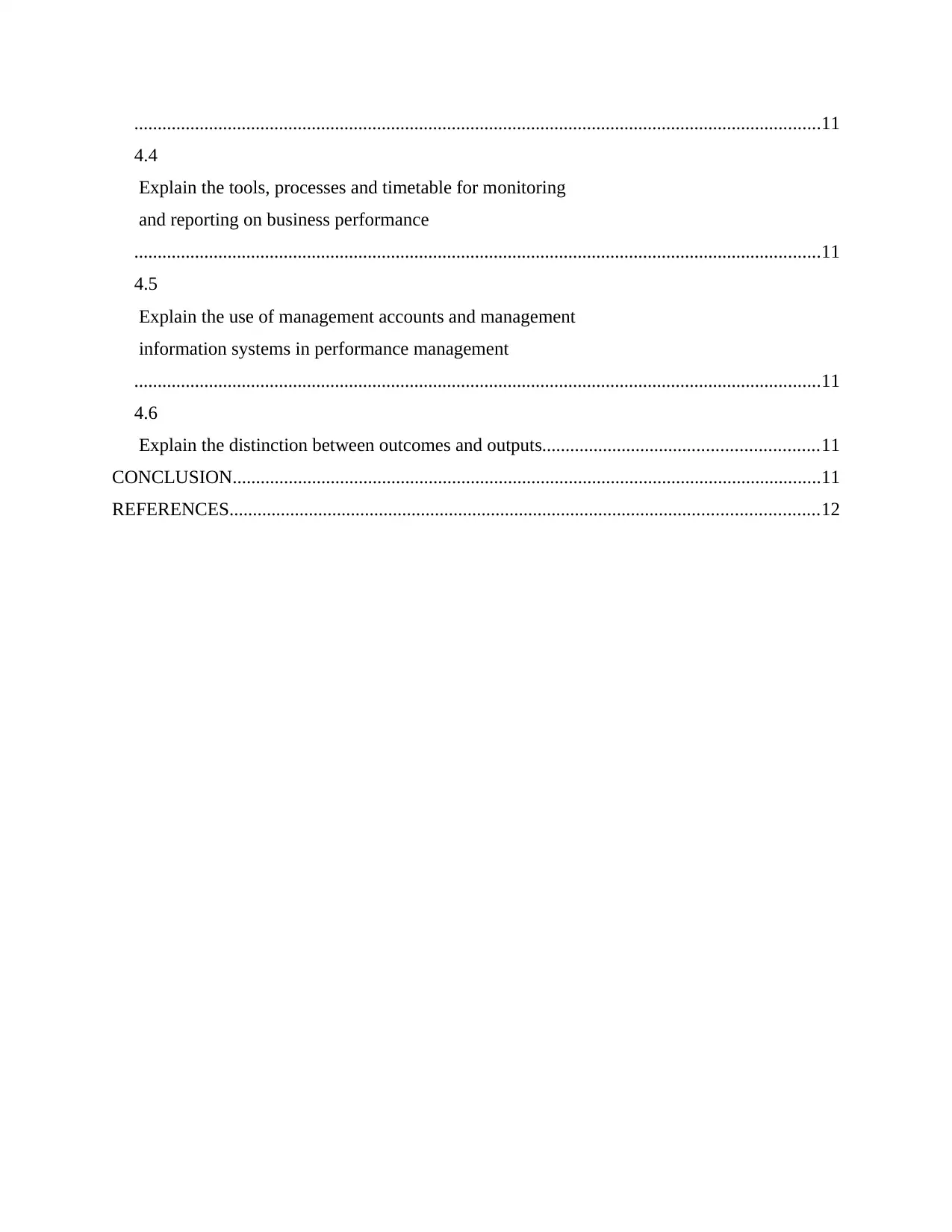
...................................................................................................................................................11
4.4
Explain the tools, processes and timetable for monitoring
and reporting on business performance
...................................................................................................................................................11
4.5
Explain the use of management accounts and management
information systems in performance management
...................................................................................................................................................11
4.6
Explain the distinction between outcomes and outputs...........................................................11
CONCLUSION..............................................................................................................................11
REFERENCES..............................................................................................................................12
4.4
Explain the tools, processes and timetable for monitoring
and reporting on business performance
...................................................................................................................................................11
4.5
Explain the use of management accounts and management
information systems in performance management
...................................................................................................................................................11
4.6
Explain the distinction between outcomes and outputs...........................................................11
CONCLUSION..............................................................................................................................11
REFERENCES..............................................................................................................................12
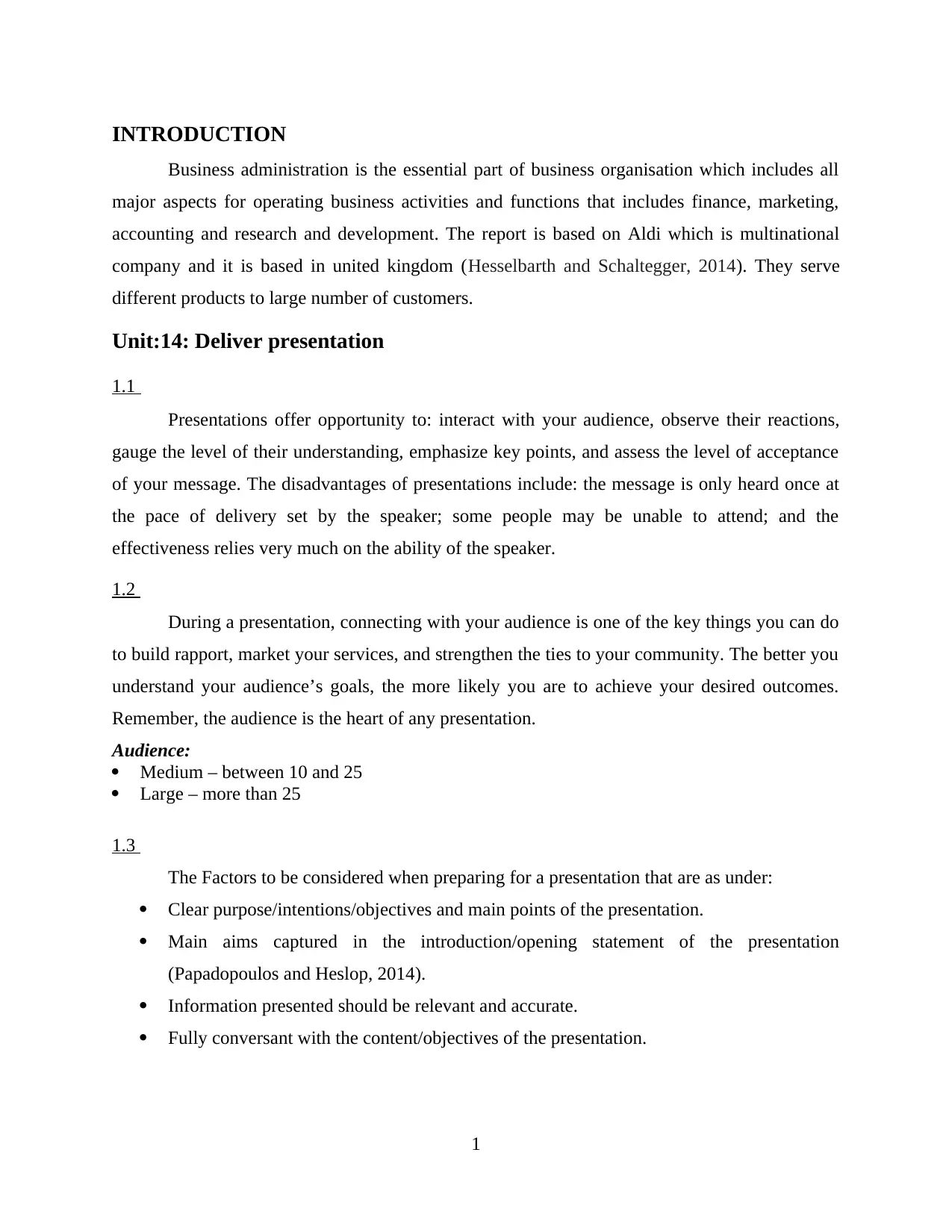
INTRODUCTION
Business administration is the essential part of business organisation which includes all
major aspects for operating business activities and functions that includes finance, marketing,
accounting and research and development. The report is based on Aldi which is multinational
company and it is based in united kingdom (Hesselbarth and Schaltegger, 2014). They serve
different products to large number of customers.
Unit:14: Deliver presentation
1.1
Presentations offer opportunity to: interact with your audience, observe their reactions,
gauge the level of their understanding, emphasize key points, and assess the level of acceptance
of your message. The disadvantages of presentations include: the message is only heard once at
the pace of delivery set by the speaker; some people may be unable to attend; and the
effectiveness relies very much on the ability of the speaker.
1.2
During a presentation, connecting with your audience is one of the key things you can do
to build rapport, market your services, and strengthen the ties to your community. The better you
understand your audience’s goals, the more likely you are to achieve your desired outcomes.
Remember, the audience is the heart of any presentation.
Audience:
Medium – between 10 and 25
Large – more than 25
1.3
The Factors to be considered when preparing for a presentation that are as under:
Clear purpose/intentions/objectives and main points of the presentation.
Main aims captured in the introduction/opening statement of the presentation
(Papadopoulos and Heslop, 2014).
Information presented should be relevant and accurate.
Fully conversant with the content/objectives of the presentation.
1
Business administration is the essential part of business organisation which includes all
major aspects for operating business activities and functions that includes finance, marketing,
accounting and research and development. The report is based on Aldi which is multinational
company and it is based in united kingdom (Hesselbarth and Schaltegger, 2014). They serve
different products to large number of customers.
Unit:14: Deliver presentation
1.1
Presentations offer opportunity to: interact with your audience, observe their reactions,
gauge the level of their understanding, emphasize key points, and assess the level of acceptance
of your message. The disadvantages of presentations include: the message is only heard once at
the pace of delivery set by the speaker; some people may be unable to attend; and the
effectiveness relies very much on the ability of the speaker.
1.2
During a presentation, connecting with your audience is one of the key things you can do
to build rapport, market your services, and strengthen the ties to your community. The better you
understand your audience’s goals, the more likely you are to achieve your desired outcomes.
Remember, the audience is the heart of any presentation.
Audience:
Medium – between 10 and 25
Large – more than 25
1.3
The Factors to be considered when preparing for a presentation that are as under:
Clear purpose/intentions/objectives and main points of the presentation.
Main aims captured in the introduction/opening statement of the presentation
(Papadopoulos and Heslop, 2014).
Information presented should be relevant and accurate.
Fully conversant with the content/objectives of the presentation.
1
⊘ This is a preview!⊘
Do you want full access?
Subscribe today to unlock all pages.

Trusted by 1+ million students worldwide
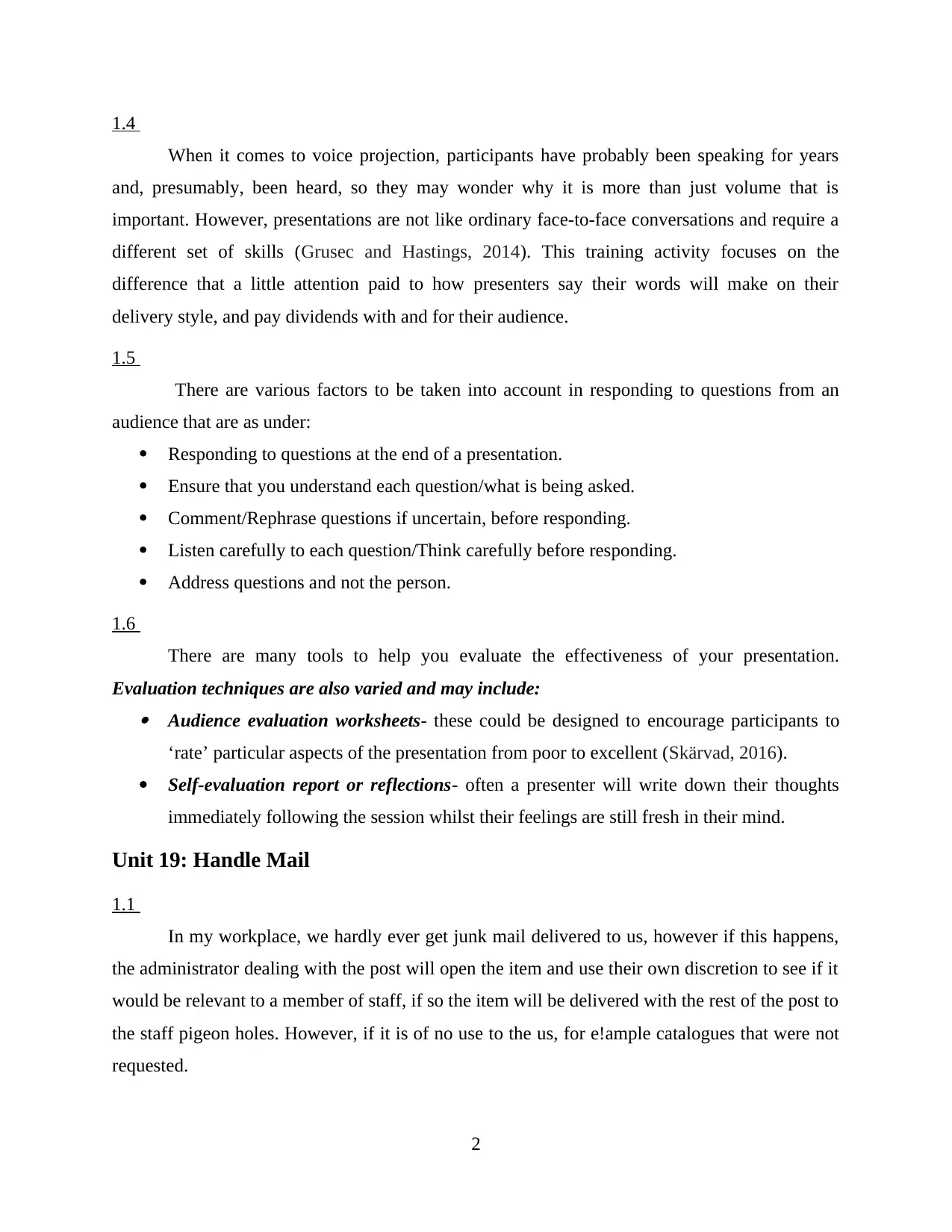
1.4
When it comes to voice projection, participants have probably been speaking for years
and, presumably, been heard, so they may wonder why it is more than just volume that is
important. However, presentations are not like ordinary face-to-face conversations and require a
different set of skills (Grusec and Hastings, 2014). This training activity focuses on the
difference that a little attention paid to how presenters say their words will make on their
delivery style, and pay dividends with and for their audience.
1.5
There are various factors to be taken into account in responding to questions from an
audience that are as under:
Responding to questions at the end of a presentation.
Ensure that you understand each question/what is being asked.
Comment/Rephrase questions if uncertain, before responding.
Listen carefully to each question/Think carefully before responding.
Address questions and not the person.
1.6
There are many tools to help you evaluate the effectiveness of your presentation.
Evaluation techniques are also varied and may include: Audience evaluation worksheets- these could be designed to encourage participants to
‘rate’ particular aspects of the presentation from poor to excellent (Skärvad, 2016).
Self-evaluation report or reflections- often a presenter will write down their thoughts
immediately following the session whilst their feelings are still fresh in their mind.
Unit 19: Handle Mail
1.1
In my workplace, we hardly ever get junk mail delivered to us, however if this happens,
the administrator dealing with the post will open the item and use their own discretion to see if it
would be relevant to a member of staff, if so the item will be delivered with the rest of the post to
the staff pigeon holes. However, if it is of no use to the us, for e!ample catalogues that were not
requested.
2
When it comes to voice projection, participants have probably been speaking for years
and, presumably, been heard, so they may wonder why it is more than just volume that is
important. However, presentations are not like ordinary face-to-face conversations and require a
different set of skills (Grusec and Hastings, 2014). This training activity focuses on the
difference that a little attention paid to how presenters say their words will make on their
delivery style, and pay dividends with and for their audience.
1.5
There are various factors to be taken into account in responding to questions from an
audience that are as under:
Responding to questions at the end of a presentation.
Ensure that you understand each question/what is being asked.
Comment/Rephrase questions if uncertain, before responding.
Listen carefully to each question/Think carefully before responding.
Address questions and not the person.
1.6
There are many tools to help you evaluate the effectiveness of your presentation.
Evaluation techniques are also varied and may include: Audience evaluation worksheets- these could be designed to encourage participants to
‘rate’ particular aspects of the presentation from poor to excellent (Skärvad, 2016).
Self-evaluation report or reflections- often a presenter will write down their thoughts
immediately following the session whilst their feelings are still fresh in their mind.
Unit 19: Handle Mail
1.1
In my workplace, we hardly ever get junk mail delivered to us, however if this happens,
the administrator dealing with the post will open the item and use their own discretion to see if it
would be relevant to a member of staff, if so the item will be delivered with the rest of the post to
the staff pigeon holes. However, if it is of no use to the us, for e!ample catalogues that were not
requested.
2
Paraphrase This Document
Need a fresh take? Get an instant paraphrase of this document with our AI Paraphraser
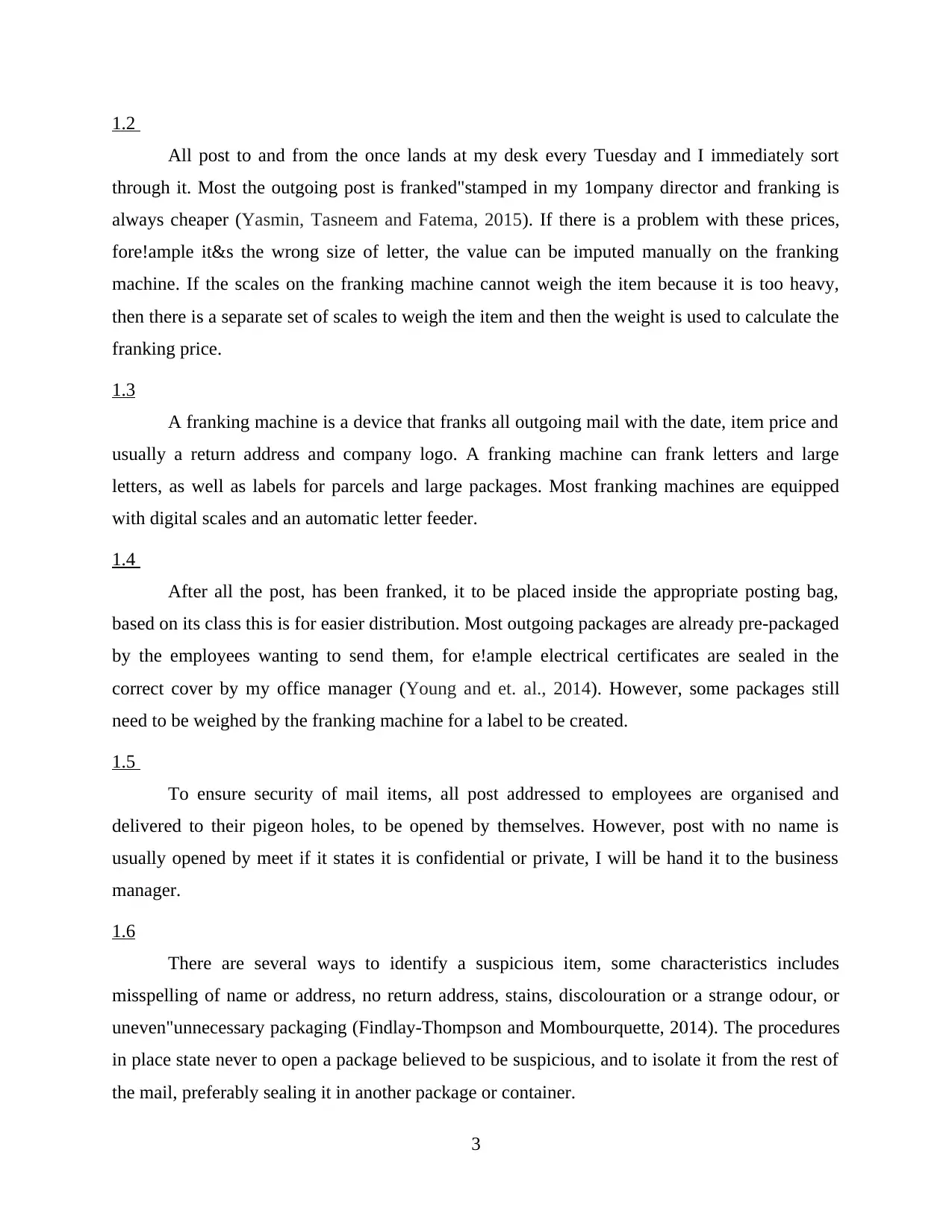
1.2
All post to and from the once lands at my desk every Tuesday and I immediately sort
through it. Most the outgoing post is franked"stamped in my 1ompany director and franking is
always cheaper (Yasmin, Tasneem and Fatema, 2015). If there is a problem with these prices,
fore!ample it&s the wrong size of letter, the value can be imputed manually on the franking
machine. If the scales on the franking machine cannot weigh the item because it is too heavy,
then there is a separate set of scales to weigh the item and then the weight is used to calculate the
franking price.
1.3
A franking machine is a device that franks all outgoing mail with the date, item price and
usually a return address and company logo. A franking machine can frank letters and large
letters, as well as labels for parcels and large packages. Most franking machines are equipped
with digital scales and an automatic letter feeder.
1.4
After all the post, has been franked, it to be placed inside the appropriate posting bag,
based on its class this is for easier distribution. Most outgoing packages are already pre-packaged
by the employees wanting to send them, for e!ample electrical certificates are sealed in the
correct cover by my office manager (Young and et. al., 2014). However, some packages still
need to be weighed by the franking machine for a label to be created.
1.5
To ensure security of mail items, all post addressed to employees are organised and
delivered to their pigeon holes, to be opened by themselves. However, post with no name is
usually opened by meet if it states it is confidential or private, I will be hand it to the business
manager.
1.6
There are several ways to identify a suspicious item, some characteristics includes
misspelling of name or address, no return address, stains, discolouration or a strange odour, or
uneven"unnecessary packaging (Findlay-Thompson and Mombourquette, 2014). The procedures
in place state never to open a package believed to be suspicious, and to isolate it from the rest of
the mail, preferably sealing it in another package or container.
3
All post to and from the once lands at my desk every Tuesday and I immediately sort
through it. Most the outgoing post is franked"stamped in my 1ompany director and franking is
always cheaper (Yasmin, Tasneem and Fatema, 2015). If there is a problem with these prices,
fore!ample it&s the wrong size of letter, the value can be imputed manually on the franking
machine. If the scales on the franking machine cannot weigh the item because it is too heavy,
then there is a separate set of scales to weigh the item and then the weight is used to calculate the
franking price.
1.3
A franking machine is a device that franks all outgoing mail with the date, item price and
usually a return address and company logo. A franking machine can frank letters and large
letters, as well as labels for parcels and large packages. Most franking machines are equipped
with digital scales and an automatic letter feeder.
1.4
After all the post, has been franked, it to be placed inside the appropriate posting bag,
based on its class this is for easier distribution. Most outgoing packages are already pre-packaged
by the employees wanting to send them, for e!ample electrical certificates are sealed in the
correct cover by my office manager (Young and et. al., 2014). However, some packages still
need to be weighed by the franking machine for a label to be created.
1.5
To ensure security of mail items, all post addressed to employees are organised and
delivered to their pigeon holes, to be opened by themselves. However, post with no name is
usually opened by meet if it states it is confidential or private, I will be hand it to the business
manager.
1.6
There are several ways to identify a suspicious item, some characteristics includes
misspelling of name or address, no return address, stains, discolouration or a strange odour, or
uneven"unnecessary packaging (Findlay-Thompson and Mombourquette, 2014). The procedures
in place state never to open a package believed to be suspicious, and to isolate it from the rest of
the mail, preferably sealing it in another package or container.
3
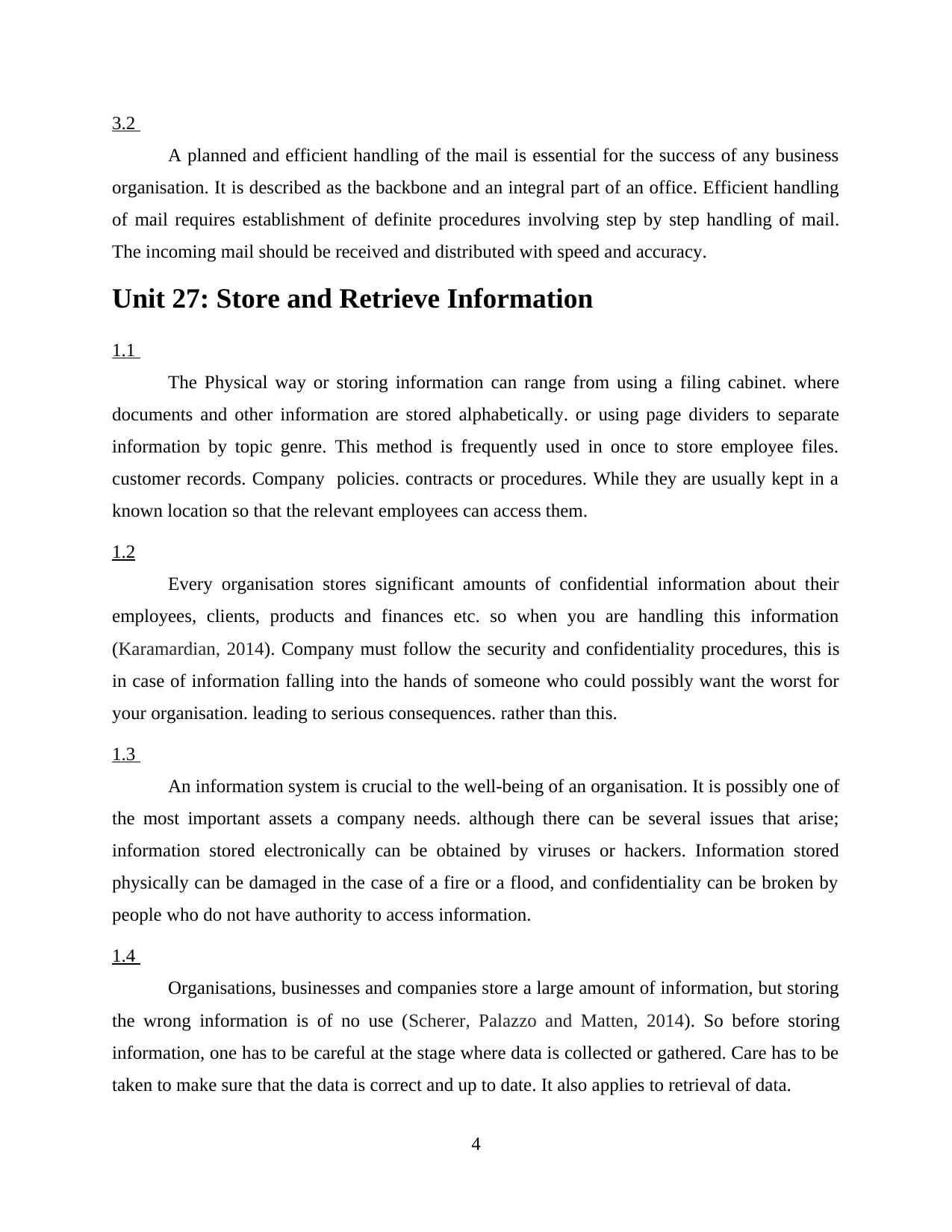
3.2
A planned and efficient handling of the mail is essential for the success of any business
organisation. It is described as the backbone and an integral part of an office. Efficient handling
of mail requires establishment of definite procedures involving step by step handling of mail.
The incoming mail should be received and distributed with speed and accuracy.
Unit 27: Store and Retrieve Information
1.1
The Physical way or storing information can range from using a filing cabinet. where
documents and other information are stored alphabetically. or using page dividers to separate
information by topic genre. This method is frequently used in once to store employee files.
customer records. Company policies. contracts or procedures. While they are usually kept in a
known location so that the relevant employees can access them.
1.2
Every organisation stores significant amounts of confidential information about their
employees, clients, products and finances etc. so when you are handling this information
(Karamardian, 2014). Company must follow the security and confidentiality procedures, this is
in case of information falling into the hands of someone who could possibly want the worst for
your organisation. leading to serious consequences. rather than this.
1.3
An information system is crucial to the well-being of an organisation. It is possibly one of
the most important assets a company needs. although there can be several issues that arise;
information stored electronically can be obtained by viruses or hackers. Information stored
physically can be damaged in the case of a fire or a flood, and confidentiality can be broken by
people who do not have authority to access information.
1.4
Organisations, businesses and companies store a large amount of information, but storing
the wrong information is of no use (Scherer, Palazzo and Matten, 2014). So before storing
information, one has to be careful at the stage where data is collected or gathered. Care has to be
taken to make sure that the data is correct and up to date. It also applies to retrieval of data.
4
A planned and efficient handling of the mail is essential for the success of any business
organisation. It is described as the backbone and an integral part of an office. Efficient handling
of mail requires establishment of definite procedures involving step by step handling of mail.
The incoming mail should be received and distributed with speed and accuracy.
Unit 27: Store and Retrieve Information
1.1
The Physical way or storing information can range from using a filing cabinet. where
documents and other information are stored alphabetically. or using page dividers to separate
information by topic genre. This method is frequently used in once to store employee files.
customer records. Company policies. contracts or procedures. While they are usually kept in a
known location so that the relevant employees can access them.
1.2
Every organisation stores significant amounts of confidential information about their
employees, clients, products and finances etc. so when you are handling this information
(Karamardian, 2014). Company must follow the security and confidentiality procedures, this is
in case of information falling into the hands of someone who could possibly want the worst for
your organisation. leading to serious consequences. rather than this.
1.3
An information system is crucial to the well-being of an organisation. It is possibly one of
the most important assets a company needs. although there can be several issues that arise;
information stored electronically can be obtained by viruses or hackers. Information stored
physically can be damaged in the case of a fire or a flood, and confidentiality can be broken by
people who do not have authority to access information.
1.4
Organisations, businesses and companies store a large amount of information, but storing
the wrong information is of no use (Scherer, Palazzo and Matten, 2014). So before storing
information, one has to be careful at the stage where data is collected or gathered. Care has to be
taken to make sure that the data is correct and up to date. It also applies to retrieval of data.
4
⊘ This is a preview!⊘
Do you want full access?
Subscribe today to unlock all pages.

Trusted by 1+ million students worldwide
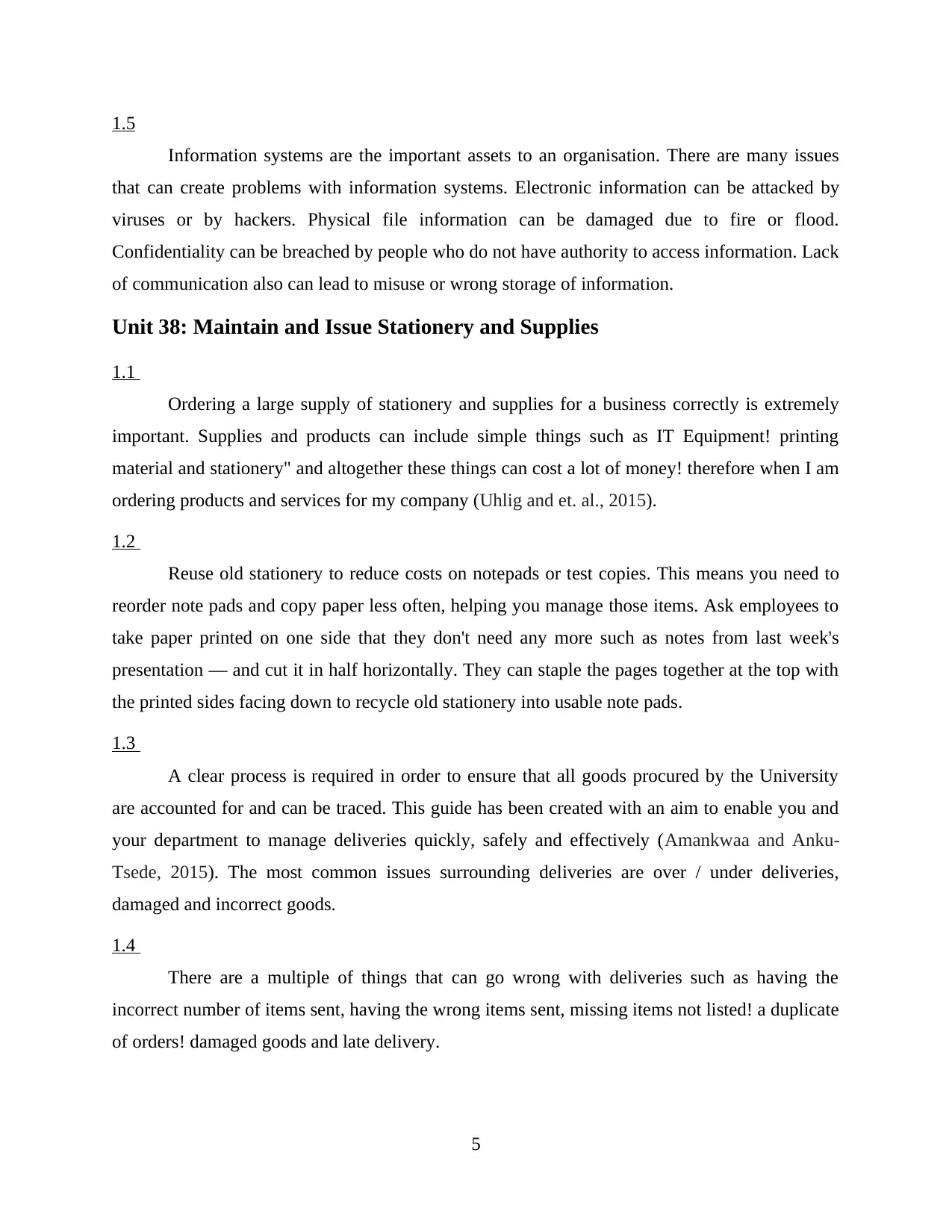
1.5
Information systems are the important assets to an organisation. There are many issues
that can create problems with information systems. Electronic information can be attacked by
viruses or by hackers. Physical file information can be damaged due to fire or flood.
Confidentiality can be breached by people who do not have authority to access information. Lack
of communication also can lead to misuse or wrong storage of information.
Unit 38: Maintain and Issue Stationery and Supplies
1.1
Ordering a large supply of stationery and supplies for a business correctly is extremely
important. Supplies and products can include simple things such as IT Equipment! printing
material and stationery" and altogether these things can cost a lot of money! therefore when I am
ordering products and services for my company (Uhlig and et. al., 2015).
1.2
Reuse old stationery to reduce costs on notepads or test copies. This means you need to
reorder note pads and copy paper less often, helping you manage those items. Ask employees to
take paper printed on one side that they don't need any more such as notes from last week's
presentation — and cut it in half horizontally. They can staple the pages together at the top with
the printed sides facing down to recycle old stationery into usable note pads.
1.3
A clear process is required in order to ensure that all goods procured by the University
are accounted for and can be traced. This guide has been created with an aim to enable you and
your department to manage deliveries quickly, safely and effectively (Amankwaa and Anku-
Tsede, 2015). The most common issues surrounding deliveries are over / under deliveries,
damaged and incorrect goods.
1.4
There are a multiple of things that can go wrong with deliveries such as having the
incorrect number of items sent, having the wrong items sent, missing items not listed! a duplicate
of orders! damaged goods and late delivery.
5
Information systems are the important assets to an organisation. There are many issues
that can create problems with information systems. Electronic information can be attacked by
viruses or by hackers. Physical file information can be damaged due to fire or flood.
Confidentiality can be breached by people who do not have authority to access information. Lack
of communication also can lead to misuse or wrong storage of information.
Unit 38: Maintain and Issue Stationery and Supplies
1.1
Ordering a large supply of stationery and supplies for a business correctly is extremely
important. Supplies and products can include simple things such as IT Equipment! printing
material and stationery" and altogether these things can cost a lot of money! therefore when I am
ordering products and services for my company (Uhlig and et. al., 2015).
1.2
Reuse old stationery to reduce costs on notepads or test copies. This means you need to
reorder note pads and copy paper less often, helping you manage those items. Ask employees to
take paper printed on one side that they don't need any more such as notes from last week's
presentation — and cut it in half horizontally. They can staple the pages together at the top with
the printed sides facing down to recycle old stationery into usable note pads.
1.3
A clear process is required in order to ensure that all goods procured by the University
are accounted for and can be traced. This guide has been created with an aim to enable you and
your department to manage deliveries quickly, safely and effectively (Amankwaa and Anku-
Tsede, 2015). The most common issues surrounding deliveries are over / under deliveries,
damaged and incorrect goods.
1.4
There are a multiple of things that can go wrong with deliveries such as having the
incorrect number of items sent, having the wrong items sent, missing items not listed! a duplicate
of orders! damaged goods and late delivery.
5
Paraphrase This Document
Need a fresh take? Get an instant paraphrase of this document with our AI Paraphraser
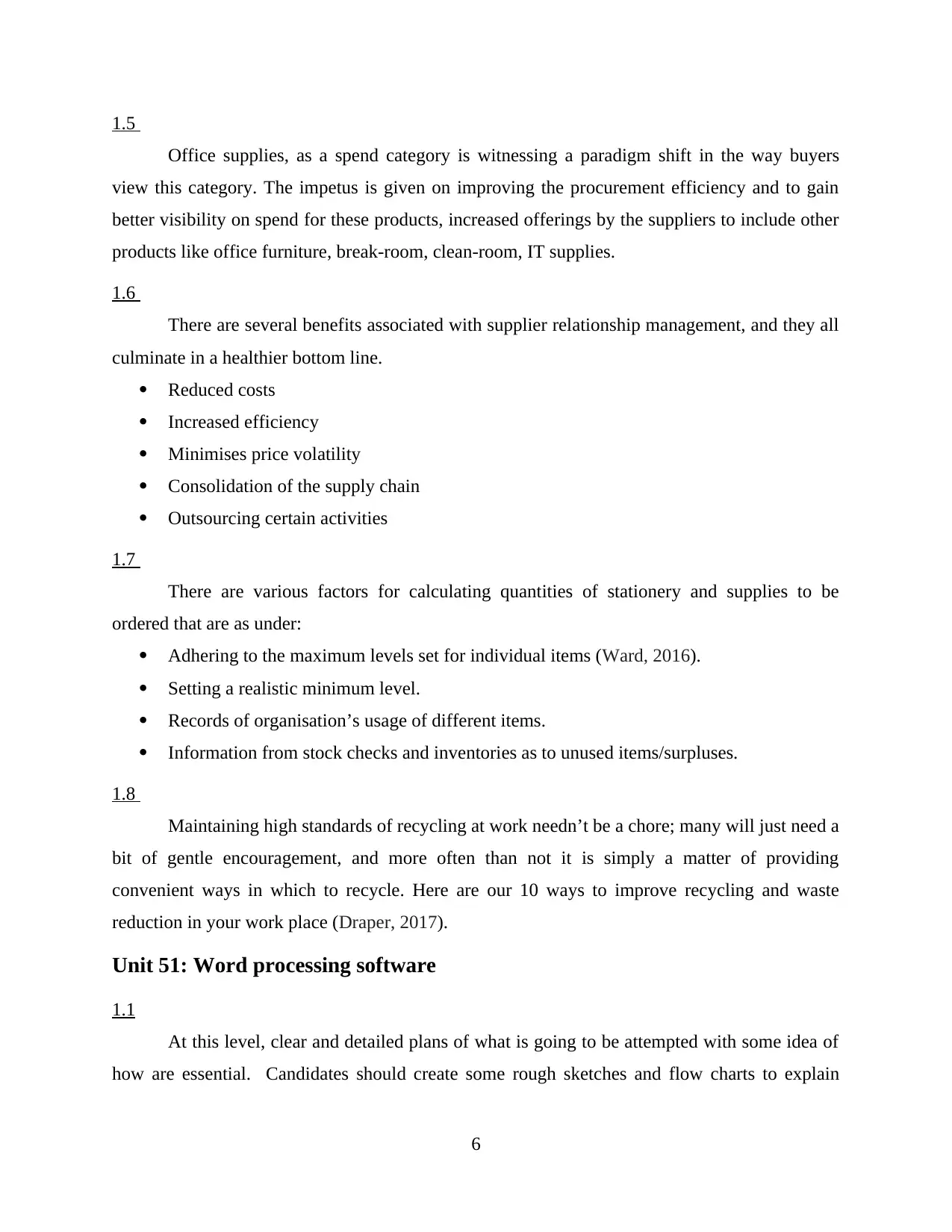
1.5
Office supplies, as a spend category is witnessing a paradigm shift in the way buyers
view this category. The impetus is given on improving the procurement efficiency and to gain
better visibility on spend for these products, increased offerings by the suppliers to include other
products like office furniture, break-room, clean-room, IT supplies.
1.6
There are several benefits associated with supplier relationship management, and they all
culminate in a healthier bottom line.
Reduced costs
Increased efficiency
Minimises price volatility
Consolidation of the supply chain
Outsourcing certain activities
1.7
There are various factors for calculating quantities of stationery and supplies to be
ordered that are as under:
Adhering to the maximum levels set for individual items (Ward, 2016).
Setting a realistic minimum level.
Records of organisation’s usage of different items.
Information from stock checks and inventories as to unused items/surpluses.
1.8
Maintaining high standards of recycling at work needn’t be a chore; many will just need a
bit of gentle encouragement, and more often than not it is simply a matter of providing
convenient ways in which to recycle. Here are our 10 ways to improve recycling and waste
reduction in your work place (Draper, 2017).
Unit 51: Word processing software
1.1
At this level, clear and detailed plans of what is going to be attempted with some idea of
how are essential. Candidates should create some rough sketches and flow charts to explain
6
Office supplies, as a spend category is witnessing a paradigm shift in the way buyers
view this category. The impetus is given on improving the procurement efficiency and to gain
better visibility on spend for these products, increased offerings by the suppliers to include other
products like office furniture, break-room, clean-room, IT supplies.
1.6
There are several benefits associated with supplier relationship management, and they all
culminate in a healthier bottom line.
Reduced costs
Increased efficiency
Minimises price volatility
Consolidation of the supply chain
Outsourcing certain activities
1.7
There are various factors for calculating quantities of stationery and supplies to be
ordered that are as under:
Adhering to the maximum levels set for individual items (Ward, 2016).
Setting a realistic minimum level.
Records of organisation’s usage of different items.
Information from stock checks and inventories as to unused items/surpluses.
1.8
Maintaining high standards of recycling at work needn’t be a chore; many will just need a
bit of gentle encouragement, and more often than not it is simply a matter of providing
convenient ways in which to recycle. Here are our 10 ways to improve recycling and waste
reduction in your work place (Draper, 2017).
Unit 51: Word processing software
1.1
At this level, clear and detailed plans of what is going to be attempted with some idea of
how are essential. Candidates should create some rough sketches and flow charts to explain
6
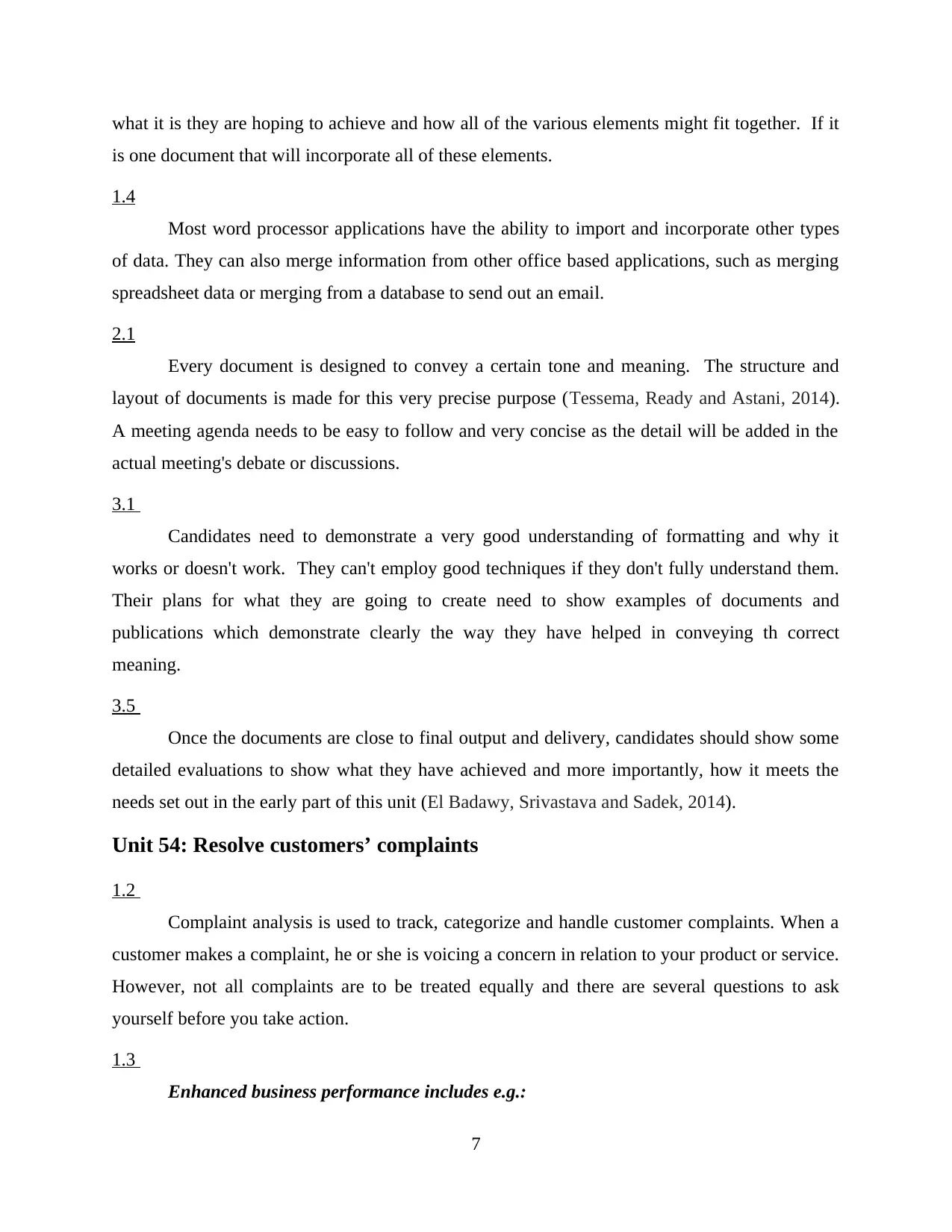
what it is they are hoping to achieve and how all of the various elements might fit together. If it
is one document that will incorporate all of these elements.
1.4
Most word processor applications have the ability to import and incorporate other types
of data. They can also merge information from other office based applications, such as merging
spreadsheet data or merging from a database to send out an email.
2.1
Every document is designed to convey a certain tone and meaning. The structure and
layout of documents is made for this very precise purpose (Tessema, Ready and Astani, 2014).
A meeting agenda needs to be easy to follow and very concise as the detail will be added in the
actual meeting's debate or discussions.
3.1
Candidates need to demonstrate a very good understanding of formatting and why it
works or doesn't work. They can't employ good techniques if they don't fully understand them.
Their plans for what they are going to create need to show examples of documents and
publications which demonstrate clearly the way they have helped in conveying th correct
meaning.
3.5
Once the documents are close to final output and delivery, candidates should show some
detailed evaluations to show what they have achieved and more importantly, how it meets the
needs set out in the early part of this unit (El Badawy, Srivastava and Sadek, 2014).
Unit 54: Resolve customers’ complaints
1.2
Complaint analysis is used to track, categorize and handle customer complaints. When a
customer makes a complaint, he or she is voicing a concern in relation to your product or service.
However, not all complaints are to be treated equally and there are several questions to ask
yourself before you take action.
1.3
Enhanced business performance includes e.g.:
7
is one document that will incorporate all of these elements.
1.4
Most word processor applications have the ability to import and incorporate other types
of data. They can also merge information from other office based applications, such as merging
spreadsheet data or merging from a database to send out an email.
2.1
Every document is designed to convey a certain tone and meaning. The structure and
layout of documents is made for this very precise purpose (Tessema, Ready and Astani, 2014).
A meeting agenda needs to be easy to follow and very concise as the detail will be added in the
actual meeting's debate or discussions.
3.1
Candidates need to demonstrate a very good understanding of formatting and why it
works or doesn't work. They can't employ good techniques if they don't fully understand them.
Their plans for what they are going to create need to show examples of documents and
publications which demonstrate clearly the way they have helped in conveying th correct
meaning.
3.5
Once the documents are close to final output and delivery, candidates should show some
detailed evaluations to show what they have achieved and more importantly, how it meets the
needs set out in the early part of this unit (El Badawy, Srivastava and Sadek, 2014).
Unit 54: Resolve customers’ complaints
1.2
Complaint analysis is used to track, categorize and handle customer complaints. When a
customer makes a complaint, he or she is voicing a concern in relation to your product or service.
However, not all complaints are to be treated equally and there are several questions to ask
yourself before you take action.
1.3
Enhanced business performance includes e.g.:
7
⊘ This is a preview!⊘
Do you want full access?
Subscribe today to unlock all pages.

Trusted by 1+ million students worldwide
1 out of 19
Related Documents
Your All-in-One AI-Powered Toolkit for Academic Success.
+13062052269
info@desklib.com
Available 24*7 on WhatsApp / Email
![[object Object]](/_next/static/media/star-bottom.7253800d.svg)
Unlock your academic potential
Copyright © 2020–2025 A2Z Services. All Rights Reserved. Developed and managed by ZUCOL.





